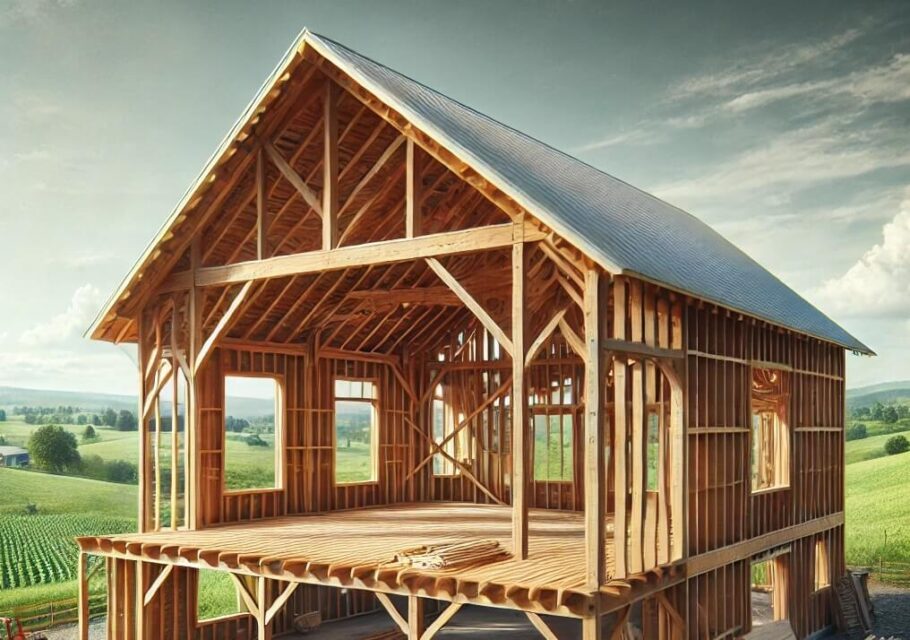When building a barndominium, one of the most critical decisions you’ll face is choosing the frame material. Steel and wood are the two most common options, each offering distinct advantages and drawbacks. Your choice will impact the durability, cost, aesthetics, and maintenance of your barndominium.
In this blog, we’ll break down the key differences between steel and wood framing to help you make an informed decision that aligns with your needs, budget, and vision.
Key Differences between Steel and Wood Barndominium Framing
1. Durability and Strength
Steel Frames
Steel is renowned for its strength and resilience, making it an excellent choice for barndominiums.
- Resistance to Elements: Steel frames can withstand extreme weather, such as high winds, heavy snow, and earthquakes.
- Pest Resistance: Steel is impervious to termites and other pests, ensuring the structural integrity of your home remains intact over time.
- Longevity: A steel frame can last decades with minimal maintenance, making it a long-term investment.
Wood Frames
Wood frames, while strong, are more susceptible to environmental factors.
- Natural Flexibility: Wood has a certain level of flexibility, making it suitable for areas with minor seismic activity.
- Susceptibility: Wood can rot, warp, or be damaged by termites, especially in humid climates, requiring regular maintenance.
Verdict: Steel wins for its superior durability and ability to resist environmental challenges.
2. Cost
Steel Frames
Steel frames often come with a higher upfront cost due to material and manufacturing expenses. However, the long-term savings from reduced maintenance and repairs can offset the initial investment.
Wood Frames
Wood is generally more affordable upfront, making it a popular choice for budget-conscious builders. However, maintenance costs, including treatments for pests and potential repairs, can add up over time.
Verdict: If you prioritize upfront affordability, wood is the better choice. For long-term cost savings, steel offers better value.
3. Aesthetic Appeal
Steel Frames
Steel frames are typically concealed behind walls, allowing for modern or industrial aesthetics. Exposed steel beams can also create a sleek, contemporary look.
- Versatility: Steel complements minimalist and modern interior designs.
- Customization: Although versatile, steel doesn’t offer the same warmth as natural wood.
Wood Frames
Wood is a natural choice for rustic, farmhouse-style designs, which align with the traditional charm of barndominiums.
- Warmth and Character: Exposed wooden beams add coziness and a classic aesthetic.
- Stain Options: Wood can be stained or painted to match your desired look.
Verdict: Wood is the winner for traditional or rustic aesthetics, while steel suits modern designs.
4. Environmental Impact
Steel Frames
Steel is recyclable, making it an environmentally friendly choice for sustainable construction. However, producing steel requires significant energy and resources, contributing to a larger carbon footprint upfront.
Wood Frames
Wood is a renewable resource, and sourcing lumber from sustainable forests can reduce its environmental impact. However, wood’s vulnerability to pests and weather may lead to waste over time.
Verdict: Both materials have pros and cons in terms of environmental impact. Opt for sustainably sourced wood or recycled steel for an eco-friendly option.
5. Construction Speed and Ease
Steel Frames
Steel frames are pre-engineered, allowing for quick assembly. They also provide precise measurements, reducing errors during construction. However, working with steel requires specialized tools and expertise.
Wood Frames
Wood is easier to work with and widely used in residential construction, meaning more builders are familiar with it. This can speed up construction timelines in areas where steel framing is less common.
Verdict: Wood is generally faster and easier to work with, especially in traditional construction settings.
6. Fire Resistance
Steel Frames
Steel is non-combustible and offers excellent fire resistance, adding an extra layer of safety.
Wood Frames
Wood is combustible and can act as fuel for fires. Fire-resistant treatments can mitigate this risk but add to maintenance costs.
Verdict: Steel provides superior fire resistance, making it the safer choice in fire-prone areas.
7. Versatility in Design
Steel Frames
Steel offers high tensile strength, allowing for wide-open spaces without the need for interior load-bearing walls. This makes it ideal for open-concept barndominiums.
Wood Frames
Wood is flexible in design and easy to modify, but it may require additional support for large open spaces.
Verdict: Steel is better for creating open-concept designs, while wood offers flexibility for smaller, compartmentalized layouts.
8. Maintenance
Steel Frames
Steel requires minimal maintenance. It’s resistant to rot, pests, and weather damage, saving you time and money.
Wood Frames
Wood needs regular inspections, treatments, and repairs to address rot, pests, and warping.
Verdict: Steel is the low-maintenance option, while wood requires ongoing care.
Conclusion
Choosing between steel and wood for your barndominium frame depends on your priorities. If durability, low maintenance, and modern design are at the top of your list, steel is the ideal choice. However, if you’re looking for a budget-friendly option with a warm, rustic aesthetic, wood might be the better fit.
At Alldraft Design Services, we understand that every barndominium is unique. Our team is here to help you weigh the pros and cons of each material and design a frame that perfectly suits your vision. Contact us today to start building the barndominium of your dreams!

